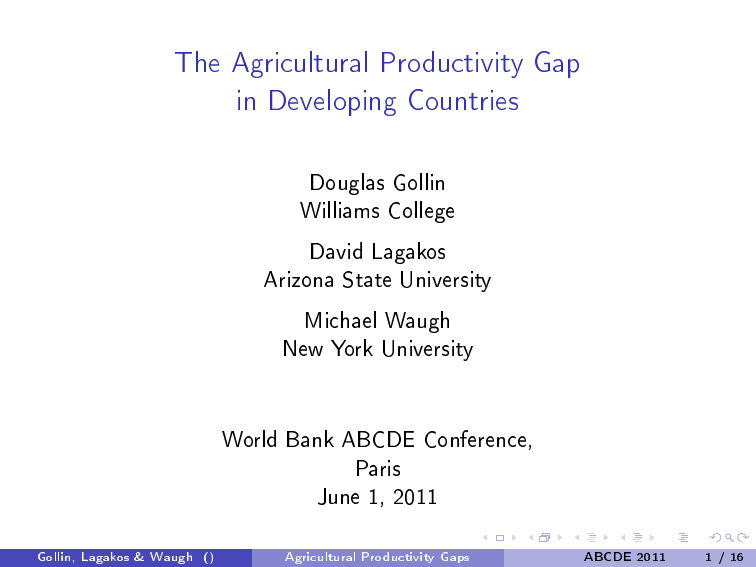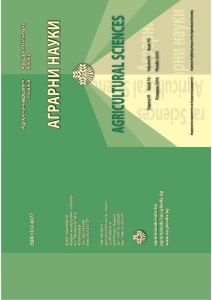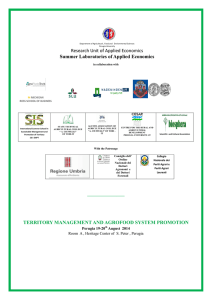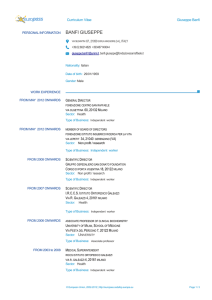The Agricultural Productivity Gap in Developing Countries
advertisement

The Agricultural Productivity Gap in Developing Countries Douglas Gollin Williams College David Lagakos Arizona State University Michael Waugh New York University World Bank ABCDE Conference, Paris June 1, 2011 Gollin, Lagakos & Waugh () Agricultural Productivity Gaps ABCDE 2011 1 / 16 Agricultural Productivity Gaps In most sub-Saharan countries, agriculture is a large sector in terms of employment and output. But typically agriculture's share of employment is much higher than its share of GDP. Is this evidence of allocative ineciency? McMillan and Rodrik (2011): report potential gains from moving workers out of agriculture and into other sectors. Potentially important policy implications. Gollin, Lagakos & Waugh () Agricultural Productivity Gaps ABCDE 2011 4 / 16 Some Questions about Productivity Gaps This paper asks what we actually know about these productivity gaps. I I I I Are the gaps measured accurately? How could large gaps persist? Can labor market rigidities possibly explain gaps of the magnitude found in the data? What other explanations might be relevant? Gollin, Lagakos & Waugh () Agricultural Productivity Gaps ABCDE 2011 5 / 16 Relevant Literature Productivity gaps are widely noted in the literature as far back as Kuznets and, of course, Lewis. I I I Gollin, Parente, and Rogerson (2004) documented productivity gaps for a large set of countries. Caselli (2005) argued that cross-country income dierences must be closely related to dierences in agricultural productivity. Related work by Restuccia, Yang, Zhu (2008), Vollrath (2009). Micro data systematically nds evidence of lower living standards in rural areas. I Ravallion, Chen, and Sangraula (2007) Gollin, Lagakos & Waugh () Agricultural Productivity Gaps ABCDE 2011 6 / 16 A First Look at the Data What do the data show? I I Agriculture's share of employment high. Share of value added lower than share of employment. Gollin, Lagakos & Waugh () Agricultural Productivity Gaps ABCDE 2011 8 / 16 Agriculture Shares of GDP and Workforce 60 MYA LAO MWI TZA ETH SLE CAF 40 BDI MLI UZB KGZ NGA GUY TON KHM SYR BTN SWZ PRY MNGPAK FJI ARM BGD NIC STP DMA MDA MAR SRB BOLCHN SEN PHL BLR BLZ EGY IDN TUN GTM HND CPV ROM LKA MKD SLV THA MNE URY IRN DZA NAM VCG MHL TUR COL CRI MYS UKR IRQ BGR GAB GRD KAZ AZE DOM ECU PER ARG PAN JAM SUR MDV MUS BRA CUB LCA RUS LBN VEN POL LTU BWA CHL MEX JORZAF 0 20 VA share of Agriculture 80 100 Figure: Agriculture shares in developing countries 0 20 40 RWA NPL SDNLBRPNG BFA TCD KEN IND MDG UGA GMB CIV ZMBGIN CMR WSM ALB VNM TJK ZWE YEM LSO GEO GHA 60 80 100 Empoyment Share of Agriculture Gollin, Lagakos & Waugh () Agricultural Productivity Gaps ABCDE 2011 9 / 16 Implications of the Raw Data Taken at face value, these data imply that value added per worker ( VA ) L is lower in agriculture than in the non-agricultural sector. The implied productivity gaps are large. Gollin, Lagakos & Waugh () Agricultural Productivity Gaps ABCDE 2011 10 / 16 Agricultural Productivity Gap We dene the Agricultural Productivity Gap (APG) to be APG n /Ln ≡ VA VAa /La Simple two-sector model says APG should be 1. Typical developing country has APG of 4. Some (particularly in sub-Saharan Africa) have APGs of 8 or more! Gollin, Lagakos & Waugh () Agricultural Productivity Gaps ABCDE 2011 11 / 16 Simple Two-Sector Model ◮ Technologies Ya = Aa Lθa Ka1−θ and Yn = An Lθn Kn1−θ ◮ Competitive labor markets ◮ Households can supply labor to either sector ◮ Then, in equilbrium: APG ≡ VAn /Ln Yn /Ln = = 1. VAa /La pa Ya /La ”Raw” Agricultural Productivity Gaps Measure Weighted Unweighted 5th Percentile 1.7 1.1 Median 3.7 3.0 Mean 4.2 3.6 95th Percentile 5.4 8.8 Number of Countries 112 112 Sub-Saharan Productivity Gaps In general, the APGs are largest for the poorest countries. They are even larger, however, for sub-Saharan countries. A number of African countries have APGs greater than 10. Gollin, Lagakos & Waugh () Agricultural Productivity Gaps ABCDE 2011 2/5 ”Raw” Agricultural Productivity Gaps 6 4 0 2 Number of Countries 6 4 2 0 Number of Countries 8 Asia 8 Africa 4 8 12 16 0 4 8 APG APG Americas Europe 12 16 12 16 6 4 0 2 Number of Countries 8 6 4 2 0 Number of Countries 8 0 0 4 8 APG 12 16 0 4 8 APG Possible Implications of Large APGs APGs appear to explain much of cross-country disparities in GDP per worker. Appear to suggest massive misallocation. Policy debate: encourage movement out of agriculture? Our view: gaps may reect measurement issues; need to ask more questions. Gollin, Lagakos & Waugh () Agricultural Productivity Gaps ABCDE 2011 12 / 16 What Do Agricultural Productivity Gaps Reect? Sector dierences in hours worked per worker? Construct measures of hours worked by sector for 56 countries Sector dierences in human capital per worker? Construct measures of human capital by sector for 127 countries Urban-rural dierences in cost of living? Use cost-of-living data for 87 countries from World Bank Measurement error in national accounts data? Use household income/expenditure surveys from 20+ countries Gollin, Lagakos & Waugh () Agricultural Productivity Gaps ABCDE 2011 13 / 16 What Do Agricultural Productivity Gaps Reect? Sector dierences in hours worked per worker? Construct measures of hours worked by sector for 56 countries Sector dierences in human capital per worker? Construct measures of human capital by sector for 127 countries Urban-rural dierences in cost of living? Use cost-of-living data for 87 countries from World Bank Measurement error in national accounts data? Use household income/expenditure surveys from 20+ countries Gollin, Lagakos & Waugh () Agricultural Productivity Gaps ABCDE 2011 13 / 16 What Do Agricultural Productivity Gaps Reect? Sector dierences in hours worked per worker? Construct measures of hours worked by sector for 56 countries Sector dierences in human capital per worker? Construct measures of human capital by sector for 127 countries Urban-rural dierences in cost of living? Use cost-of-living data for 87 countries from World Bank Measurement error in national accounts data? Use household income/expenditure surveys from 20+ countries Gollin, Lagakos & Waugh () Agricultural Productivity Gaps ABCDE 2011 13 / 16 What Do Agricultural Productivity Gaps Reect? Sector dierences in hours worked per worker? Construct measures of hours worked by sector for 56 countries Sector dierences in human capital per worker? Construct measures of human capital by sector for 127 countries Urban-rural dierences in cost of living? Use cost-of-living data for 87 countries from World Bank Measurement error in national accounts data? Use household income/expenditure surveys from 20+ countries Gollin, Lagakos & Waugh () Agricultural Productivity Gaps ABCDE 2011 13 / 16 What Do Agricultural Productivity Gaps Reect? Sector dierences in hours worked per worker? Construct measures of hours worked by sector for 56 countries Sector dierences in human capital per worker? Construct measures of human capital by sector for 127 countries Urban-rural dierences in cost of living? Use cost-of-living data for 87 countries from World Bank Measurement error in national accounts data? Use household income/expenditure surveys from 20+ countries Gollin, Lagakos & Waugh () Agricultural Productivity Gaps ABCDE 2011 13 / 16 What Do Agricultural Productivity Gaps Reect? Sector dierences in hours worked per worker? Construct measures of hours worked by sector for 56 countries Sector dierences in human capital per worker? Construct measures of human capital by sector for 127 countries Urban-rural dierences in cost of living? Use cost-of-living data for 87 countries from World Bank Measurement error in national accounts data? Use household income/expenditure surveys from 20+ countries Gollin, Lagakos & Waugh () Agricultural Productivity Gaps ABCDE 2011 13 / 16 What Do Agricultural Productivity Gaps Reect? Sector dierences in hours worked per worker? Construct measures of hours worked by sector for 56 countries Sector dierences in human capital per worker? Construct measures of human capital by sector for 127 countries Urban-rural dierences in cost of living? Use cost-of-living data for 87 countries from World Bank Measurement error in national accounts data? Use household income/expenditure surveys from 20+ countries Gollin, Lagakos & Waugh () Agricultural Productivity Gaps ABCDE 2011 13 / 16 What Do Agricultural Productivity Gaps Reect? Sector dierences in hours worked per worker? Construct measures of hours worked by sector for 56 countries Sector dierences in human capital per worker? Construct measures of human capital by sector for 127 countries Urban-rural dierences in cost of living? Use cost-of-living data for 87 countries from World Bank Measurement error in national accounts data? Use household income/expenditure surveys from 20+ countries Gollin, Lagakos & Waugh () Agricultural Productivity Gaps ABCDE 2011 13 / 16 Preview of Results After adjustments, APG in average developing country reduced from 4 to 2. Household survey data also suggest big sector income gaps. Puzzling that gaps are still so large. Gollin, Lagakos & Waugh () Agricultural Productivity Gaps ABCDE 2011 14 / 16 ”Simple” Measurement Questions ◮ National accounts exclude production of agriculture for own consumption? ◮ Rural people counted as agricultural workers? ”Simple” Measurement Questions ◮ National accounts exclude production of agriculture for own consumption? No, it is included. ◮ Rural people counted as agricultural workers? ”Simple” Measurement Questions ◮ National accounts exclude production of agriculture for own consumption? ◮ Rural people counted as agricultural workers? No, only ”economically active” persons should be included. ”Simple” Measurement Questions ◮ National accounts exclude production of agriculture for own consumption? ◮ Rural people counted as agricultural workers? In practice, official estimates similar to our surveys. 100 80 TZA UGA GIN VNM 60 NPL KEN GHA 40 SEN ARM ROM 20 ECU PER ZAF BOL CUB COL CHL JOR VEN BLR 0 Employment share of Agriculture (Our Estimates) Agriculture Sector in Developing Countries 0 20 40 60 80 Empoyment Share of Agriculture (Official Data) 100 Sector Differences in Hours Worked ◮ Average hours worked per worker might differ across sectors ◮ We construct average hours worked per worker by sector for 56 countries - Population census micro data or labor force surveys - All employed or unemployed persons 15+ years old - Industry of primary employment (employed); industry of previous employment or rural/urban status (unemployed) - Hours worked in reference period (usually one week) 2.0 1.0 TUR KEN FJI MYS SWZ PHL CRI RWA IDN LBR MEX SYR PER KHM ZAF BOLSLE PAN CHL BGD BWA PAK DOM VEN BTN NPLLKA CHN TONLCA ECU ROM NGA BRA TZA 50 40 1.5 ARM JOR LSO ZMB IRQ JAM GHA ETH 30 UGA 20 Hours Worked in Non−Agriculture 60 Sector Differences in Hours Worked 20 30 40 Hours Worked in Agriculture 50 60 Sector Differences in Hours Worked: Summary ◮ Explains on average a factor 1.2 ◮ Only a few countries above 1.5 ◮ Unlikely to be the main cause of APGs in developing countries Sector Differences in Human Capital ◮ Relevant for U.S. development experience (Caselli & Coleman, 2001); developing countries today (Vollrath, 2009) ◮ We construct human capital per worker by sector for 127 countries - Same sources, sample selection as for hours - Years of schooling measured directly when available - Impute years of schooling using educational attainment otherwise - Baseline: assume 10% rate of return on year of schooling (Psacharoplous & Patrinos 2002; Banerjee & Duflo, 2005) 2.0 1.5 1.0 UKR GEOARM KGZ KAZ ROMMDA UZB CUB BLR AZETON CHL SRBGUY JOR TJK PAN MHL LTU MKD ALB PERARG JAM ZAF COL PHLZWE ECU SWZ BLZ FJI BOL CHN NAM CRI MEX IDN NGA ZMB DOM VNM VENSLV THA EGY SUR MDV LSO UGA PRY HND MYS PNG SYR MWI CMR BRA YEM GHA IND MDG GTM BWA TZATUR IRQ NIC GAB LAO LBR PAKLCA ETH BDI RWA KEN IRN BGD KHMBTN SLE STP CAF MAR GMB NPL CIV SDN BFA TCD SEN GIN 5 10 MNG MLI 0 Years of Schooling in Non−Agriculture 15 Sector Differences in Years of Schooling 0 5 10 Years of Schooling in Agriculture 15 10 2.0 5 SWZ ZWE NAM NGA ZMB EGY UGA LSO MWI CMR GHA MDG BWA TZA GAB LBR ETH BDI RWA KEN SLE STP CAF MAR GMB CIV SDN BFA TCD SEN GIN 1.5 1.0 ZAF MLI 0 Years of Schooling in Non−Agriculture 15 Sector Differences in Years of Schooling: Just Africa 0 5 10 Years of Schooling in Agriculture 15 2.0 1.5 ROM MDA 1.0 UKRGEO ARM KGZ KAZ MNG UZB BLR CUB SRBGUYAZE TON TJK JOR PAN LTU MHL MKD ALB PER JAM ARG ZAF COL PHLZWE ECU SWZ BLZ FJI BOL CHN NAM CRI MEX IDN NGA DOM ZMB VNM VEN SLV THA EGY MDV LSO SUR UGA HND PRY MYS PNG MWI SYR CMR BRA YEM GHA IND BWA G TM MDG TZA IRQ TUR GAB NIC LAO LCA ETH LBR PAK BTN BDIRWA KEN BGDSTP IRN KHM CAF SLE MAR GMB NPL SDN BFA CIV TCD SEN GIN MLI 2 3 CHL 1 Human Capital in Non−Agriculture 4 Sector Differences in Human Capital 1 2 3 Human Capital in Agriculture 4 Quality Differences in Schooling ◮ Rural schools often of lower quality than urban schools (Williams, 2005; Zhang, 2006) ◮ Potentially overestimate human capital among agriculture workers ◮ We use literacy data to adjust for schooling quality Uganda: Literacy by Years of Schooling Completed (" Literacy Rate !#'" !#&" !#%" !#$" !" !" $" %" &" '" Years of Schooling )*)+,-".*/01/2" ,-".*/01/2" (!" Measuring Quality Differences in Schooling ◮ Given literacy rates by years of schooling: ℓni (s) and ℓai (s) for s = 1, 2, ... ◮ Assume that one year in rural school is worth γ years in urban school ◮ For each country i, solve for γi that solves min γ ¯ s “ X ℓ˜ni (γs) − ℓ˜ai (s) ”2 s=1 where ℓ˜ni (·), ℓ˜ai (·) are polynomial interpolations of ℓni (·), ℓai (·) for s ∈ [0, ¯s ]. Measuring Quality Differences in Schooling Table 3: Rural-Urban Education Quality Differences Country γˆ Argentina 0.87 Bolivia 0.95 Brazil 0.89 Chile 0.92 Ghana 0.90 Guinea 0.62 Malaysia 0.93 Mali 0.89 Mexico 0.77 Panama 0.87 Philippines 0.80 Rwanda 0.88 Tanzania 1.25 Thailand 0.90 Uganda 0.82 Venezuela 0.78 Vietnam 0.74 Average 0.87 1.80 PAN 1.60 MEX VEN PHL BOL UGA GHA BRA ARGCHL MYS VNM 1.40 RWA THA GIN 1.20 MLI TZA 1.00 Human Capital Ratio, Quality Adjusted 2.00 Quality-Adjusted and Unadjusted Human Capital 1.00 1.20 1.40 1.60 Human Capital Ratio, Unadjusted 1.80 2.00 Sector Differences in Human Capital: Summary ◮ Explains on average a factor 1.4 ◮ Range (10th-90th percentile) from 1.2 to 1.6 ◮ Quality adjustments using literacy data don’t change results much ◮ Even assuming rural years of schooling are worth 1/2 as much as urban, still get only a factor 1.6 on average, maximum of 2.1 15 10 5 0 Number of Countries 20 25 Cost-of-Living Differences 0.9 1.0 1.1 1.2 1.3 1.4 1.5 Urban/Rural Cost of Living 1.6 1.7 1.8 ”Adjusted” Agricultural Productivity Gaps Measure Countries w/ Complete Data All Countries 5th Percentile 1.1 0.8 Median 2.3 1.8 Mean 2.0 1.9 95th Percentile 2.6 2.6 Number of Countries 34 112 10 8 6 4 RWA ZMB JAM 2 LSO IDN TUR CHN UGA PAK ROM BRA BGD ARM MEX ZAF TZA CHL DOMNPL BWA ETH KEN BOL NGA VEN PAN PHL GHA PER KHM CRI ECU SWZ JOR 0 Adjusted APG 12 14 16 Raw vs Adjusted Gaps 0 2 4 6 8 Raw APG 10 12 14 16 4 3 JAM LSO 1 2 IDN CHN TUR PAK ROMBRA BGD ARM MEX ZAF TZA CHL DOM BWA ETH KEN BOL NPL PHL NGA VEN GHA PAN PER KHM CRI ECU SWZ JOR UGA 0 Adjusted APG 5 6 7 Raw vs Adjusted Gaps 0 1 2 3 4 Raw APG 5 6 7 Raw vs Adjusted Gaps 4 8 12 30 20 16 0 4 8 12 Raw APG Complete Data, Adjusted All Countries, Adjusted 20 0 10 Number of Countries 12 8 4 0 16 30 Raw APG 16 0 Number of Countries 10 0 4 8 12 Number of Countries 16 All Countries, Raw 0 Number of Countries Complete Data, Raw 0 4 8 Adjusted APG 12 16 0 4 8 Adjusted APG 12 16 Comparing National Accounts & Household Surveys ◮ National accounts might underestimate agriculture value added/income ◮ Can compare with household income/expenditure survey evidence ◮ Use World Bank’s Living Standards Measurement Surveys (LSMS) ◮ Explicit goal of LSMS: household income and expenditure measures Comparing Macro to Micro Sector Income Measures ◮ Agricultural value added, household i VAa,i = ya,i − INTa,i ◮ ”Agricultural revenue” ya,i = J X “ ” pj xihome + ximarket + xiinvest ,j ,j ,j j=1 ◮ Non-agriculture value added VAn,i = yn,i − INTn,i Comparison of Macro and Micro APG Agriculture Share (%) of Employment Country APG Value Added Micro Macro Micro Macro Micro Cote d’Ivoire (1988) 71.0 32.0 37.7 4.3 4.0 Guatemala (2000) 40.2 15.1 16.9 3.4 3.3 Pakistan (2001) 57.8 25.8 20.5 4.2 4.3 South Africa (1993) 11.8 4.3 8.2 1.6 1.5 Computing Income, Expenditure ◮ Deaton (1997), others: consumption expenditures more reliable than income ◮ Robustness: compare VA/worker to Income/Worker and Consumption/Worker Sector Differences in VA, Income, and Expenditure from Micro Data Country VA/Worker Income/Worker Consumption/Worker Cote d’Ivoire (1988) 4.0 3.7 3.5 Guatemala (2000) 3.3 3.3 2.6 Pakistan (2000) 4.3 5.3 1.9 South Africa (1993) 1.5 1.6 1.7 Different Labor Shares Across Sectors? ◮ Production functions with different labor shares Ya = Aa Lθa a Ka1−θa ◮ and Yn = An Lθnn Kn1−θn In equilibrium APG = Yn /Ln θa = pa Ya /La θn Different Labor Shares Across Sectors? ◮ Production functions with different labor shares Ya = Aa Lθa a Ka1−θa ◮ Yn = An Lθnn Kn1−θn In equilibrium APG = ◮ and Yn /Ln θa = pa Ya /La θn Macro evidence on θa , θn - Employment share of agriculture varies a lot across countries; - Aggregate labor share of GDP doesn’t (Gollin, 2002) - Suggests θa isn’t much higher than θn Different Labor Shares Across Sectors? ◮ Production functions with different labor shares Ya = Aa Lθa a Ka1−θa ◮ Yn = An Lθnn Kn1−θn In equilibrium APG = ◮ and Yn /Ln θa = pa Ya /La θn Macro evidence on θa , θn - Employment share of agriculture varies a lot across countries; - Aggregate labor share of GDP doesn’t (Gollin, 2002) - Suggests θa isn’t much higher than θn ◮ Micro evidence on θa , θn - Sharecropping arrangements suggest θa ∼ 0.5 - Econometric estimates: θa ∼ 0.5 − 0.7 Conclusions Measurement problems seem to play a large role in explaining the APGs. Adjusting for simple and obvious observables reduces the APGs substantially. But large productivity gaps remain even after all our adjustments. If these numbers are accurate, they suggest a major puzzle: I Why are people not moving out of rural areas as fast as they possibly can? I What barriers or labor market rigidities could possibly keep urban populations so small? Gollin, Lagakos & Waugh () Agricultural Productivity Gaps ABCDE 2011 3/5 Possible Explanations? Harris-Todaro models suggest that riskier income in urban areas might keep people from moving; but only at entirely implausible levels of risk aversion. I (And do we really think that rural livelihoods are less risky than urban livelihoods?) Are there some unmeasured amenities to rural life? I Should we be trying to measure the value of leisure in rural areas? I Is there a value to food security and self-reliance? Gollin, Lagakos & Waugh () Agricultural Productivity Gaps ABCDE 2011 4/5 Directions for Further Research Continue pursuing measurement issues. Look for evidence of measurable rigidities in labor markets and migration costs. Consider plausibility of alternative models and explanations. Gollin, Lagakos & Waugh () Agricultural Productivity Gaps ABCDE 2011 5/5


